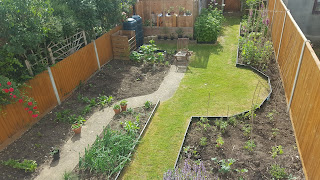One thing that's going well is that the peppers, chillies and tomatoes I've grown from seed are getting big and bushy with plenty of flowers:
I will definitely be growing chrysanthemums again next year - and possibly taking geranium cuttings again too.
Outside, it's not so clear how well the companion planting is going. I planted calendula with the carrots and leeks. Firstly, I failed to look in advance how big they were going to get, so I planted too many too close together in clumps by my approach of scattering randomly. Secondly, they're covered in some sort of black insect. Now, calendula are considered good companion plants for the very reason that they attract all the pests and keep them away from your other plants. But I'm not so sure my carrots and leeks were ever going to be affected by these.
I continue to hope that they have fooled the carrot fly. However, I am not impressed by the calendulas' colours.
I thought I had selected much more subtle shades.
Never mind. You live and learn. Speaking of which, I'm not entirely sure how sensible my decision to grow black hollyhocks was either. Up close, the individual flowers look beautiful, especially when the sun is shining on them and you see they're not so much black as very deep purple.
However, the plants as a whole swamp the flowers with their big messy leaves, almost all of which have caught hollyhock rust.
Possibly these would look good adding height to a border, but I'm not sure. I suspect hollyhocks need a flower colour that stands out more from their leaves to look really good. I think I may have to take the RHS's advice and grow them as a biennial only, removing them this year after flowering.
On the other side of the garden, my outdoor tomatoes are doing well. Although they are barely visible from a distance, I left some violas that self-seeded themselves in with them.
My squashes and courgettes have also finally started to grow. For ages they just sat there at the size at which they left the dining room or greenhouse, but now they're having a little growth spurt, I think because of all this warm weather.
Doing far less well are my beetroots, lettuces and brassicas. Slugs and snails are to blame for my brassica problems, and as I'm refusing to use slug pellets, my only recourse is to pull out the sage and marjoram where the slugs and snails are sheltering. I've been waiting for the sage to stop flowering to do so, so I don't deprive the bees. I think we're close enough to the end that I'll remove it this weekend or next, depending on how much time I get.
I'm not sure why my beetroots are doing so badly. It might be the heat. They strike me as a plant that doesn't like it too warm. My lettuce is also suffering from slugs and snails. The wee beast have removed whole plants over night. There's nothing nearby I can sensibly remove to reduce the slugs and snails in that area, so I think I'm going to have to wait till my slug rings are available from elsehwere in the garden or just accept that I won't be getting much lettuce this year.
Having had to grow my bean plants in pots until they were big enough to survive the attentions of the local snail population, my beans are now doing well. It might help that they're planted on the shady side of the garden, as I don't think they like it too hot. We'll have to see what happens when it comes to producing beans for the violetta, runner and the blue lake beans. The broad beans have done me proud, though.
My raspberries have got even huger than I remember them from last year and are getting ready to flower.
They need no help from me at all. I don't water them. I don't companion plant for them. All I do is chop off or dig up the runners when they try and send them out into the grass. Digging up is much more successful than chopping off.
Let's finish with a couple of pictures of the garden as a whole:
























































